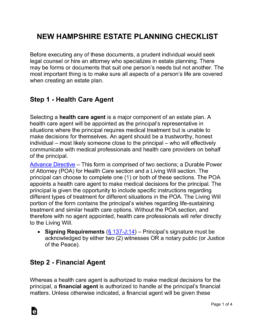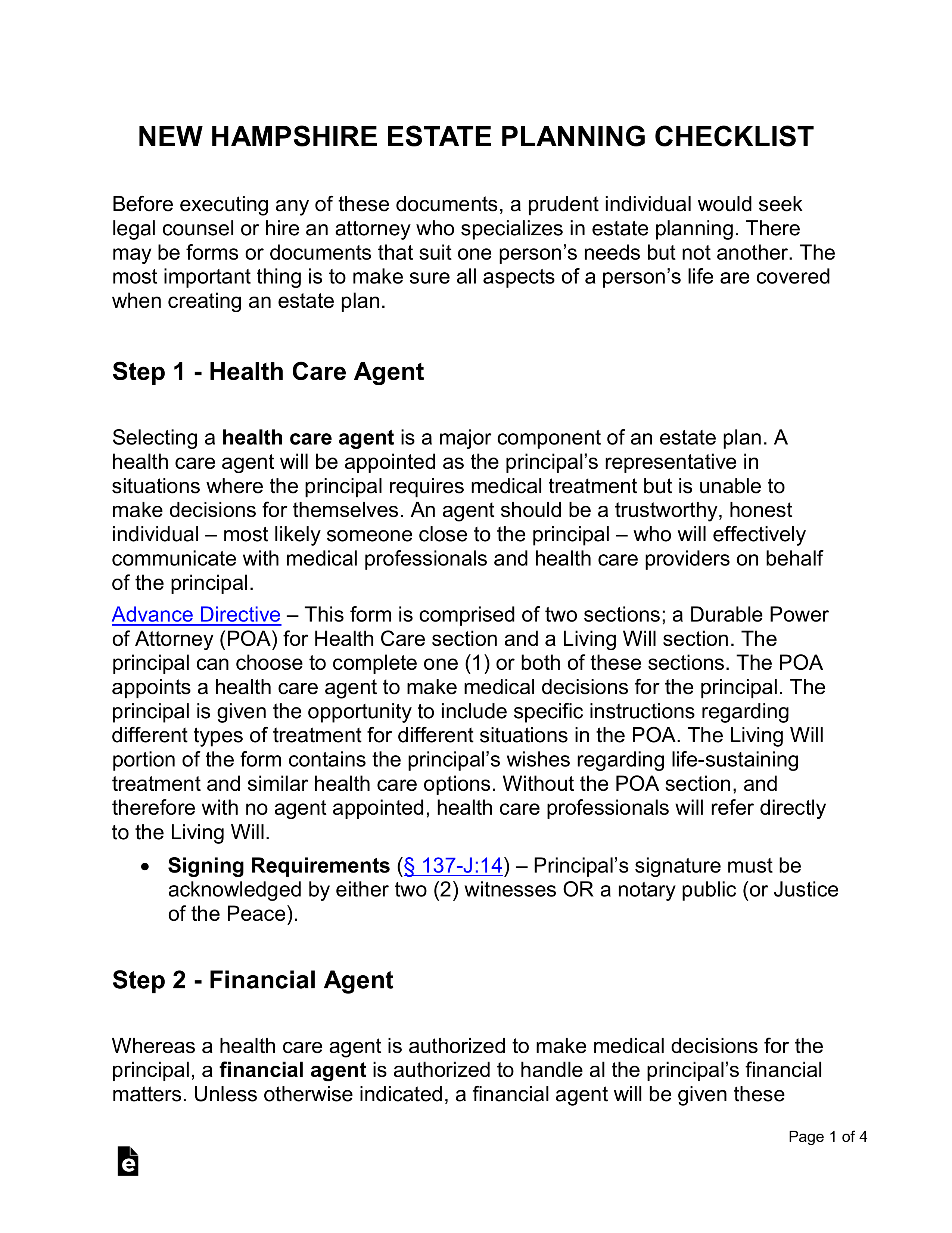Updated March 05, 2024
A New Hampshire estate planning checklist is a form that can help guide individuals who are in the process of planning the future of their estate. When someone dies or becomes incapacitated in such a way that prevents them from managing their own affairs, it’s important to have documents in place that will provide instructions for family members, business partners, and health care professionals. In the unfortunate event of a debilitating accident, a person (hereinafter referred to as a principal) would be wise to have an Advance Directive and a Durable Financial Power of Attorney already in place; these legal instruments allow a representative to act on the principal’s behalf. When a principal dies, hopefully they have executed a Last Will and Testament and/or a Living Trust, so that their loved ones can inherit or continue to benefit from the principal’s estate.
How to Create an Estate Plan in New Hampshire (6 steps)
- Health Care Agent
- Financial Agent
- List of Assets
- Beneficiaries
- Last Will and Testament / Living Trust
- Store Documents
Before executing any of these documents, a prudent individual would seek legal counsel or hire an attorney who specializes in estate planning. There may be forms or documents that suit one person’s needs but not another. The most important thing is to make sure all aspects of a person’s life are covered when creating an estate plan.
1. Health Care Agent
Selecting a health care agent is a major component of an estate plan. A health care agent will be appointed as the principal’s representative in situations where the principal requires medical treatment but is unable to make decisions for themselves. An agent should be a trustworthy, honest individual – most likely someone close to the principal – who will effectively communicate with medical professionals and health care providers on behalf of the principal.
Advance Directive – This form is comprised of two sections; a Durable Power of Attorney (POA) for Health Care section and a Living Will section. The principal can choose to complete one (1) or both of these sections. The POA appoints a health care agent to make medical decisions for the principal. The principal is given the opportunity to include specific instructions regarding different types of treatment for different situations in the POA. The Living Will portion of the form contains the principal’s wishes regarding life-sustaining treatment and similar health care options. Without the POA section, and therefore with no agent appointed, health care professionals will refer directly to the Living Will.
- Signing Requirements – Principal’s signature must be acknowledged by either two (2) witnesses OR a notary public (or Justice of the Peace).[1]
2. Financial Agent
Whereas a health care agent is authorized to make medical decisions for the principal, a financial agent is authorized to handle all the principal’s financial matters. Unless otherwise indicated, a financial agent will be given these powers whether or not the principal is incapacitated. The benefit of such an agent is that if the principal is incapable of making important financial decisions, the agent is there to make sure their estate is running smoothly.
Durable (Financial) Power of Attorney – A legal document that appoints a financial agent and conveys the principal’s wishes regarding the type(s) of power the agent wields.
- Signing Requirements – Principal must sign in the presence of a notary public or other authorized individual.[2]
Financial Powers Allowed:
- Real property[3]
- Tangible personal property[4]
- Stocks and bonds[5]
- Commodities and options[6]
- Banks and other financial institutions[7]
- Operation of entity or business[8]
- Insurance and annuities[9]
- Estates, trusts, and other beneficial interests[10]
- Claims and litigation[11]
- Personal and family maintenance[12]
- Benefits from governmental programs or civil or military service[13]
- Retirement plans[14]
- Taxes[15]
- Gifts[16]
3. List of Assets
4. Beneficiaries
5. Last Will and Testament / Living Trust
At this juncture, a principal must decide which document they will use to distribute their assets after their death. The instruments mentioned below serve different purposes, and a principal might not need to execute both of them to cover all bases. This portion of the estate planning process should be gone over with an attorney to ensure nothing has been overlooked.
Last Will and Testament – Most people will execute a Last Will and Testament well before they die so that their affairs are in order in case something unexpected happens to them. A Will includes instructions written by the testator (principal) to an executor outlining which asset goes to which beneficiary after the testator’s death. This document can be modified throughout the testator’s lifetime to include any recent amendments in regard to new property or other assets. After the testator dies, the Will must be validated by probate court to confirm its authenticity. This process can be time-consuming depending on the size of the estate and the amount of debt incurred.
- Signing Requirements – Principal and two (2) or more witnesses.[17]
(Revocable) Living Trust – The creation of a Revocable Living Trust involves the transfer of ownership of assets from the grantor (principal) to the Trust. Once the document is executed, the Living Trust becomes an entity into which assets are placed so the grantor may benefit from them during their lifetime. Beneficiaries will be named in the Trust to inherit the assets after the grantor’s death. Unlike a Will, a Living Trust avoids the probate process after the grantor’s death and remains out of public record. What a Trust does not include is instructions regarding guardianship for the grantor’s children and how taxes and debts should be paid; these elements can be covered in a Last Will and Testament.
- Signing Requirements – Although it is not specifically mentioned in State law, a Revocable Living Trust will be easier to validate if it is acknowledged by witnesses and/or a notary public.
6. Store Documents
New Hampshire Estate Planning Laws
- Advance Directive – § 137-J (Generally); § 137-J:20 (Specifically)
- Power of Attorney (Financial) – § 564-E:101(-403)
- Last Will and Testament – § 551:1(-22)
- Living Trust (Revocable) – § 564-B:6-601(-604)


